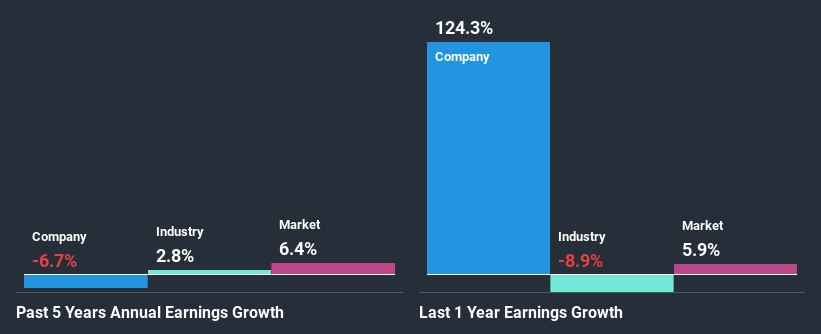Do Its Financials Have Any Role To Play In Driving Symtek Automation Asia Co., Ltd.'s (TPE:6438) Stock Up Recently?
Symtek Automation Asia's (TPE:6438) stock is up by a considerable 20% over the past three months. As most would know, fundamentals are what usually guide market price movements over the long-term, so we decided to look at the company's key financial indicators today to determine if they have any role to play in the recent price movement. In this article, we decided to focus on Symtek Automation Asia's ROE.
Return on Equity or ROE is a test of how effectively a company is growing its value and managing investors’ money. Put another way, it reveals the company's success at turning shareholder investments into profits.
See our latest analysis for Symtek Automation Asia
How To Calculate Return On Equity?
Return on equity can be calculated by using the formula:
Return on Equity = Net Profit (from continuing operations) ÷ Shareholders' Equity
So, based on the above formula, the ROE for Symtek Automation Asia is:
12% = NT$237m ÷ NT$2.0b (Based on the trailing twelve months to September 2020).
The 'return' is the profit over the last twelve months. So, this means that for every NT$1 of its shareholder's investments, the company generates a profit of NT$0.12.
Why Is ROE Important For Earnings Growth?
So far, we've learned that ROE is a measure of a company's profitability. We now need to evaluate how much profit the company reinvests or "retains" for future growth which then gives us an idea about the growth potential of the company. Assuming everything else remains unchanged, the higher the ROE and profit retention, the higher the growth rate of a company compared to companies that don't necessarily bear these characteristics.
Symtek Automation Asia's Earnings Growth And 12% ROE
To begin with, Symtek Automation Asia seems to have a respectable ROE. Further, the company's ROE compares quite favorably to the industry average of 9.6%. As you might expect, the 6.7% net income decline reported by Symtek Automation Asia is a bit of a surprise. We reckon that there could be some other factors at play here that are preventing the company's growth. For example, it could be that the company has a high payout ratio or the business has allocated capital poorly, for instance.
However, when we compared Symtek Automation Asia's growth with the industry we found that while the company's earnings have been shrinking, the industry has seen an earnings growth of 2.8% in the same period. This is quite worrisome.

The basis for attaching value to a company is, to a great extent, tied to its earnings growth. It’s important for an investor to know whether the market has priced in the company's expected earnings growth (or decline). This then helps them determine if the stock is placed for a bright or bleak future. If you're wondering about Symtek Automation Asia's's valuation, check out this gauge of its price-to-earnings ratio, as compared to its industry.
Is Symtek Automation Asia Efficiently Re-investing Its Profits?
Symtek Automation Asia's declining earnings is not surprising given how the company is spending most of its profits in paying dividends, judging by its three-year median payout ratio of 74% (or a retention ratio of 26%). With only a little being reinvested into the business, earnings growth would obviously be low or non-existent. To know the 2 risks we have identified for Symtek Automation Asia visit our risks dashboard for free.
Moreover, Symtek Automation Asia has been paying dividends for seven years, which is a considerable amount of time, suggesting that management must have perceived that the shareholders prefer consistent dividends even though earnings have been shrinking.
Summary
Overall, we feel that Symtek Automation Asia certainly does have some positive factors to consider. Although, we are disappointed to see a lack of growth in earnings even in spite of a high ROE. Bear in mind, the company reinvests a small portion of its profits, which means that investors aren't reaping the benefits of the high rate of return. Up till now, we've only made a short study of the company's growth data. To gain further insights into Symtek Automation Asia's past profit growth, check out this visualization of past earnings, revenue and cash flows.
When trading Symtek Automation Asia or any other investment, use the platform considered by many to be the Professional's Gateway to the Worlds Market, Interactive Brokers. You get the lowest-cost* trading on stocks, options, futures, forex, bonds and funds worldwide from a single integrated account. Promoted
New: Manage All Your Stock Portfolios in One Place
We've created the ultimate portfolio companion for stock investors, and it's free.
• Connect an unlimited number of Portfolios and see your total in one currency
• Be alerted to new Warning Signs or Risks via email or mobile
• Track the Fair Value of your stocks
This article by Simply Wall St is general in nature. It does not constitute a recommendation to buy or sell any stock, and does not take account of your objectives, or your financial situation. We aim to bring you long-term focused analysis driven by fundamental data. Note that our analysis may not factor in the latest price-sensitive company announcements or qualitative material. Simply Wall St has no position in any stocks mentioned.
*Interactive Brokers Rated Lowest Cost Broker by StockBrokers.com Annual Online Review 2020
Have feedback on this article? Concerned about the content? Get in touch with us directly. Alternatively, email editorial-team (at) simplywallst.com.
About TWSE:6438
Symtek Automation Asia
Manufactures and sells automation equipment and related products in Taiwan, China, and the United States.
Flawless balance sheet with proven track record.
Market Insights
Community Narratives




